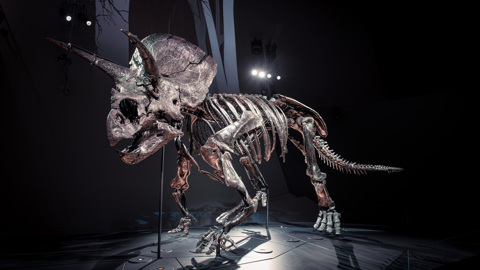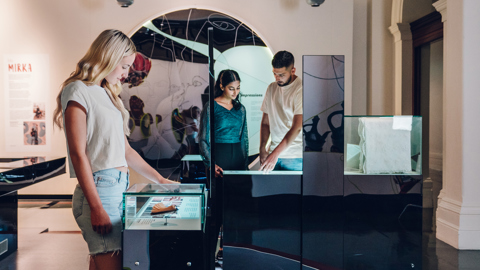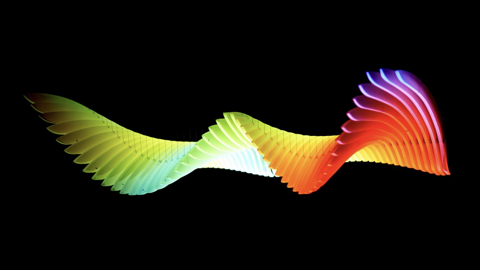Addison Kemp, Lost and Found
Transcript
Titled ‘Lost and Found’, this zine takes the form of a 32-page graphic novel that, as the Exhibitor Statement explains, explores grief, change, and healing through a coming-of-age lens. Both written and illustrated by Addison Kemp, it follows the story of Adi, a young girl experiencing the twin upheavals of loss (the deaths of her grandfather and beloved cat), and moving house. The cover features Adi: a girl with tumbling orange hair styled with a fringe and headband, bright blue eyes and wearing a dungaree dress with a central patch pocket that features an upside down heart. Above her head arcs a stretching cat, rendered in similar blue shade as Adi’s dress. A pale blue colour picks out the cat’s features (paws, eyes, nose, ears and collar) and traces its outline. Both Adi and the cat are framed in a grey archway against a background of black. Swirls of the same dual-blue tones as the cat adorn the cover. The title is written in capital letters (with an ampersand), the central letters and symbols shorter than the rest in order to accommodate the highest point of the archway. The inner cover page features a pattern of grey paw-prints. The dedication page reads ‘To the ones we’ve lost, your spirits live on.’ The next page features a white toy duck with orange feet and beak. The exterior edges of its lozenge-shaped black eyes slope downwards, as do the corners of its beak, hinting at the emotion of sadness. Hatchings on the duck’s wings, body, feet and head imply scratches and general wear and tear.
The story plays out through a series of different sized and positioned panels – predominantly in the form of simple squares and rectangles (which, as Addison explains “keep it neat and tidy and not too overwhelming. The simpler, the easier it is to follow along with a story”). Digital illustrations show Adi returning to her former home to search for her teddy.Inside the home, she encounters the spirit of her pet cat (‘Jett’ – based on Addison’s own cat, Blitz) – the ghostly blue cat featured on the zine’s cover. She also encounters the ghost of her grandfather (represented in the same tones as the cat), who explains through a series of speech bubbles that he and Jett cannot, as Adi wishes, accompany her to her new home because “this is your next step in life Adi, not mine”. Adi’s wide eyes quiver with tears. Jett rubs against her bare leg. Adi’s Grandfather envelops her in a hug, saying “no one who loves us ever really leaves!”. Adi snuggles against her Grandfather then, with eyes shining, says ‘There are things we gain from loss.” Remembering her quest to find her teddy, her Grandfather reveals that “nothing is ever lost”, and suggests “maybe it’s right in front of you.” The next panel features the white toy duck, its eyes downcast, bathed in a shaft of light. As Adi scoops up the duck and cuddles it, the duck’s beak curves upwards and its eyes become wide black circles. The final panels detail Adi’s mum calling from the car outside “Did you find it?”. Standing outside her old house with the ghosts of Jett and her Grandfather, Adi cuddles her now smiling toy and replies “I found it!” The final panels features Adi’s mum, her eyes wide, her eyebrows almost hidden beneath her brown fringe. Beneath, in a box outlined with dashes are the words ‘Thank you, Dad.’ The next page features Adi’s duck-shaped teddy, now smiling. The back of the book contains the same archway as the front cover. Hovering at the top of the archway is Adi’s duck-shaped teddy. Beneath, text reads “A beautifully written, heartfelt story… Lost & Found.” The ‘Blurb’ continues: ‘As the family prepare to move to their new home, Adi can’t find her beloved toy. Adi is not ready to leave without it. While searching she discovers a bigger lesson about loss and change.” Words in smaller font continue “In loving memory of John Parker. Special thanks: Rachel Parker (editor). Jake and Paul Kemp. Cynthia Parker”.
Addisons’s accompanying portfolio is itself illustrated with pen and ink style depictions of the various stages of a caterpillar transforming into a butterfly. It documents her inspirations (Tillie Walden’s graphic novel, ‘Are you listening?’, Dani Smilek’s artwork, Little Shop of Horrors, Studio Ghibli, Wes Anderson’s ‘Moonrise Kingdom’, the ‘Five Nights at Freddy’s’ and ‘Heart Stopper’ series, ‘Avatar the last Airbender’) – analysing their use of symbolic codes (colour, mise en scene), technical codes (camerawork, lighting) and story conventions. The portfolio also traces her choice of characters (with Jett based on Addison’s own cat, Blitz) and the development of the story. She explains her choice of a more muted colour pallet, with the use of blue (as a symbolism of grief and loss) for the spirits. She uses powerful facial expressions to express characters’ emotion, and deploys naturalising sun lighting within minimalistic backgrounds.






